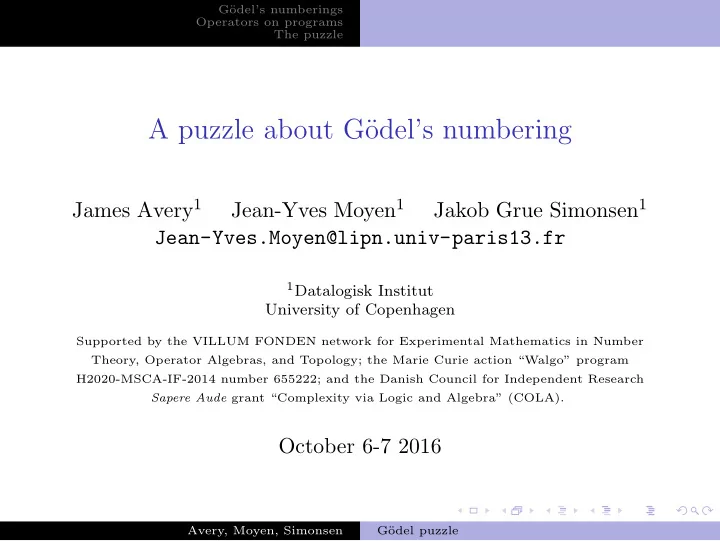

G¨ odel’s numberings Operators on programs The puzzle A puzzle about G¨ odel’s numbering James Avery 1 Jean-Yves Moyen 1 Jakob Grue Simonsen 1 Jean-Yves.Moyen@lipn.univ-paris13.fr 1 Datalogisk Institut University of Copenhagen Supported by the VILLUM FONDEN network for Experimental Mathematics in Number Theory, Operator Algebras, and Topology; the Marie Curie action “Walgo” program H2020-MSCA-IF-2014 number 655222; and the Danish Council for Independent Research Sapere Aude grant “Complexity via Logic and Algebra” (COLA). October 6-7 2016 Avery, Moyen, Simonsen G¨ odel puzzle
Part 1: the puzzle
G¨ odel’s numberings
G¨ odel’s numberings Operators on programs The puzzle G¨ odel’s numbering Historically introduced by K. G¨ odel to encode (arithmetical) formulas into numbers. Allows to manipulate formulas as arithmetical objects and thus write formulas about formulas. Proof of G¨ odel’s Incompleteness Theorem boils down to “This sentence has no proof”. Avery, Moyen, Simonsen G¨ odel puzzle
G¨ odel’s numberings Operators on programs The puzzle G¨ odel’s numbering Historical numbering: assign a number to each symbol and use power of the n-th prime to say that the symbol is in n-th position. Example: “ 0 ” is 6, “ = ” is 5. “ 0=0 ” is 2 6 × 3 5 × 5 6 = 243 , 000 , 000. Example: “the first symbol of ϕ is 0 ” = “the power of 2 in the encoding of ϕ is 6”. Used to encode Turing Machines into numbers and thus create Universal Turing Machine. Avery, Moyen, Simonsen G¨ odel puzzle
G¨ odel’s numberings Operators on programs The puzzle G¨ odel’s numberings There are many ways to encode stuff into numbers. Example: letters can be encoded using the ASCII code (’H’ is 1001000 (2) = 72). Example: strings can be encoded using ASCII + leading ’1’ (“Hello” is 1 , 1001000 , 1100101 , 1101100 , 1101100 , 1101111 (2) = 53 , 900 , 686 , 959). Example: images into .bmp files, read as one big binary number. Example: anything stored into your computer. . . In general: any injective function into the natural numbers can be considered as a G¨ odel’s numbering. Avery, Moyen, Simonsen G¨ odel puzzle
G¨ odel’s numberings Operators on programs The puzzle G¨ odel’s numbering of program A G¨ odel’s numbering of programs allow to manipulate programs with other programs. Example: compilation is a manipulation between G¨ odel’s numbering of the source and object files. A G¨ odel’s numbering does not need to be computable! Example: encode uniformly terminating programs into even numbers and other into odd numbers. Avery, Moyen, Simonsen G¨ odel puzzle
Operators on programs
G¨ odel’s numberings Operators on programs The puzzle Binary operators on programs If Pgms is a set of programs ( C , Turing machines, . . . ) we can define (binary) operators on it. F : Pgms × Pgms → Pgms . Example: sequential composition, parallel composition (with or without communication), . . . , other things? Operators can be complicated: sequential composition of C programs requires some α -conversions + cleaning headers (conflicting #define ) + . . . Operators can be non-computable: “if p and q compute inverse functions, then let F ( p , q ) be λx.x , otherwise . . . ” Avery, Moyen, Simonsen G¨ odel puzzle
G¨ odel’s numberings Operators on programs The puzzle Operators and numberings A binary operator on programs and a G¨ odel’s numbering of programs automatically define a binary operator on numbers. Example: if p is encoded by 132, q by 93 and F ( p , q ) = r , encoded by 32789; then F(132 , 93) = 32789. Avery, Moyen, Simonsen G¨ odel puzzle
The puzzle
G¨ odel’s numberings Operators on programs The puzzle The puzzle Can you choose: a Turing-complete programming language ICC system; a G¨ odel’s numbering for it; a binary operator on it; such that the induced operator on numbers is “as simple as possible”? Example: start by looking into sequential or parallel compositions (still, many choices of such operators). Example: can the operator on numbers be increasing? convex? polynomial? addition? concatenation? “continuous”? injective? other properties? Avery, Moyen, Simonsen G¨ odel puzzle
Recommend
More recommend